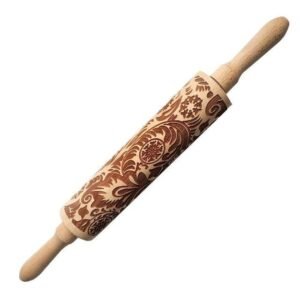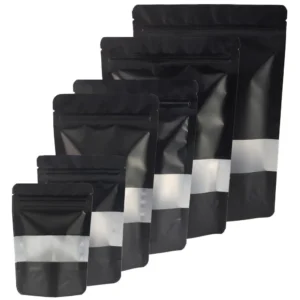Introduction
Well, during the Qing Dynasty, there was an official named Ding Baozhen who had an insatiable love for spicy food. Legend has it that Kung Pao Chicken was named after him, as he enjoyed the dish so much. Over time, this tantalizing combination of tender chicken, crunchy peanuts, and savory hoisin sauce gained popularity worldwide. Get ready to embark on a culinary adventure as we dive into the origins and delectable flavors of Kung Pao Chicken.
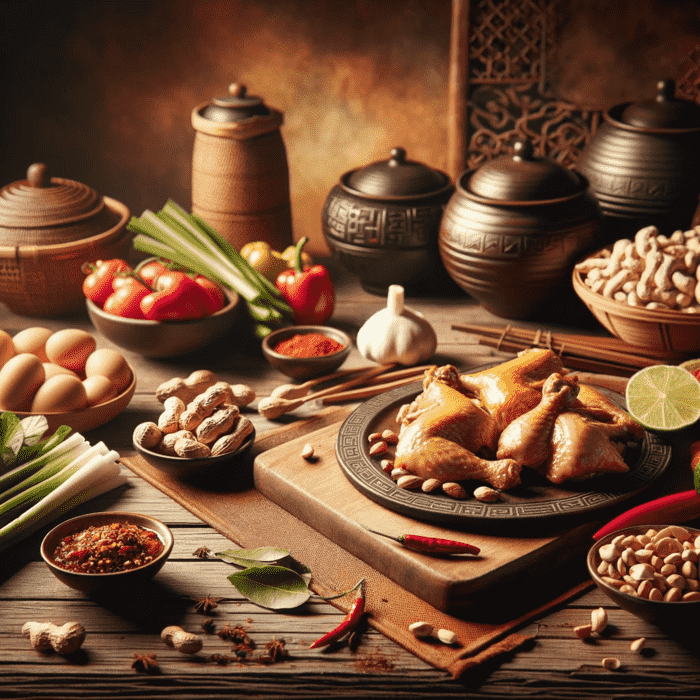
Traditional Ingredients and Cooking Techniques for Authentic Kung Pao Chicken
To create an authentic Kung Pao Chicken dish, you’ll need a few key ingredients and employ specific cooking techniques. Let’s dive into the traditional elements that make this dish so flavorful and delicious.
Ingredients: Chicken, Peanuts, and Vegetables

Authentic Kung Pao Chicken typically consists of tender chunks of chicken, crunchy peanuts, and a variety of vegetables. The combination of these ingredients creates a delightful balance of textures and flavors in every bite.
Flavors: Soy Sauce, Vinegar, and Sugar
The key to achieving the signature taste of Kung Pao sauce lies in the perfect blend of soy sauce, vinegar, and sugar. These ingredients provide a savory umami base with a hint of tanginess and sweetness.
Essential Ingredient: Sichuan Peppercorns
One ingredient that sets Kung Pao Chicken apart is the use of Sichuan peppercorns. These aromatic peppers add a unique numbing sensation to the dish, creating a distinctive flavor profile that tingles your taste buds.
Cooking Technique: Stir-Frying
Stir-frying is the preferred cooking technique for preparing Kung Pao Chicken. This method involves quickly cooking small pieces of chicken over high heat while constantly stirring them in a hot wok or skillet. Stir-frying ensures that the chicken retains its tenderness while acquiring a slightly charred exterior for added flavor.
By combining these traditional ingredients with proper stir-frying techniques, you can recreate an authentic plate of Kung Pao Chicken right at home using this recipe. Serve this delicious recipe alongside steamed rice or noodles for a complete meal bursting with bold flavors.
The Spicy Elements: Dried Peppers and Sichuan Peppercorns
The use of dried peppers and Sichuan peppercorns is essential in creating the signature spicy and numbing flavors in Sichuan cuisine.
Dried Peppers: Dried peppers, such as the famous Sichuan chili peppers, are a staple ingredient in Sichuan cuisine. They provide a fiery heat that is both intense and addictive. These peppers are typically dried under the sun until they become wrinkled and brittle. They can be used whole, crushed, or ground into a powder, depending on the desired level of spiciness. The use of dried peppers in a recipe adds depth and complexity to dishes, enhancing the overall flavor profile.
Sichuan Peppercorns: Sichuan peppercorns are another crucial element in Sichuan cuisine. Unlike traditional peppercorns, Sichuan peppercorns have a unique numbing effect on the palate, known as “ma” in Chinese cuisine. This numbing sensation, combined with the heat of the dried peppers, creates a distinctive flavor experience. Sichuan peppercorns are often toasted and ground before being added to dishes, releasing their fragrant and tingling properties.
The Perfect Sauce and Marinade for Kung Pao Chicken
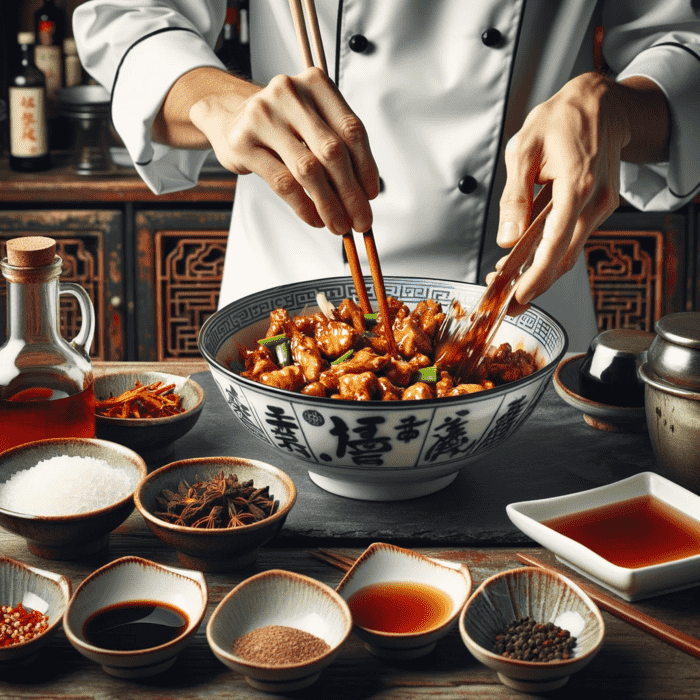
The sauce and marinade are crucial components in creating the perfect Kung Pao Chicken dish. This iconic Chinese dish is known for its bold and spicy flavors, and the sauce is what brings it all together.
To make the perfect sauce, you will need a combination of soy sauce, rice vinegar, hoisin sauce, sesame oil, and chili paste. The soy sauce provides a salty umami flavor, while the rice vinegar adds a tangy kick. The hoisin sauce adds sweetness and depth, and the sesame oil brings a rich nuttiness. Finally, the chili paste adds the necessary heat and spice that Kung Pao Chicken is known for.
Marinating the chicken in the sauce before cooking is essential to infuse it with flavor. The longer you marinate the chicken, the more flavorful it will be. It is recommended to marinate the chicken for at least 30 minutes, but if you have the time, marinating it overnight will yield the best results.
Step-by-Step Instructions for Making an Authentic Kung Pao Chicken Recipe
To create a mouthwatering kung pao chicken dish, follow these simple steps:
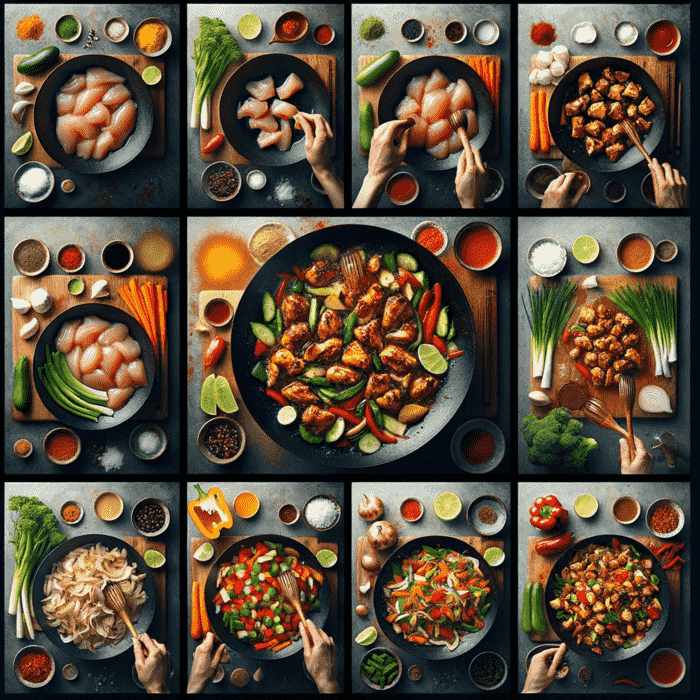
Marinate the chicken
Begin by marinating the chicken in a mixture of soy sauce, cornstarch, and rice wine. This will infuse the meat with flavor and help tenderize it.
Prepare the wok
Heat some oil in a wok or skillet over medium-high heat. Once hot, add minced garlic, grated ginger, dried peppers, and Sichuan peppercorns. These aromatic ingredients will give your kung pao chicken its signature taste.
Stir-fry the chicken
Add the diced chicken to the wok and stir-fry until it is cooked through and no longer pink. Make sure to keep stirring to prevent sticking or burning.
Add final touches
Finish off your kung pao chicken by adding peanuts and sliced scallions to the wok. These ingredients add crunch and freshness to the dish. Pour in the prepared sauce made from soy sauce, vinegar, sugar, and sesame oil. Stir everything together until well-coated.
This recipe allows you to enjoy all those delicious flavors of traditional Chinese cuisine right at home. The combination of savory chicken, spicy peppers, crunchy peanuts, and fragrant spices creates a harmonious blend that will tantalize your taste buds.
The Spicy Elements: Dried Peppers and Sichuan Peppercorns
Dried Peppers: Heat with a Smoky Twist
Dried peppers are the fiery stars of Kung Pao Chicken, bringing the heat and adding a smoky undertone to the dish. These chili peppers come in various forms, such as whole dried chilies or chili flakes. When cooked, they release their spicy essence, infusing the dish with a bold flavor that tantalizes your taste buds.
Sichuan Peppercorns: Numbing Sensations
Sichuan peppercorns are an essential ingredient in authentic Kung Pao Chicken. These tiny reddish-brown peppercorns create a unique numbing sensation on the tongue known as “mala.” This distinctive characteristic sets Sichuan cuisine apart from others. The combination of heat from the dried peppers and the tingling numbness from Sichuan peppercorns creates a harmonious balance of flavors.
Controlling Spice Levels
The beauty of making your own Kung Pao Chicken lies in having control over its spiciness level. By adjusting the amount of dried peppers and Sichuan peppercorns you use, you can customize it to suit your personal preference. If you prefer milder flavors, reduce the number of dried peppers and peppercorns. For those who crave an extra kick, add more for an intense heat experience.
Signature Flavor Boosters
Both dried peppers and Sichuan peppercorns play pivotal roles in giving Kung Pao Chicken its signature flavor profile. The marriage between these two ingredients creates a symphony of spicy, smoky, and numbing sensations that make every bite excitingly delicious.
So there you have it! The secret behind the spicy elements in Kung Pao Chicken lies within the dynamic duo of dried peppers and Sichuan peppercorns. With their combined powers, they bring the heat, smokiness, and numbing sensations that make this dish truly remarkable. Now you’re armed with the knowledge to create your own mouthwatering Kung Pao Chicken masterpiece!
Essential Tools for Making Kung Pao Chicken
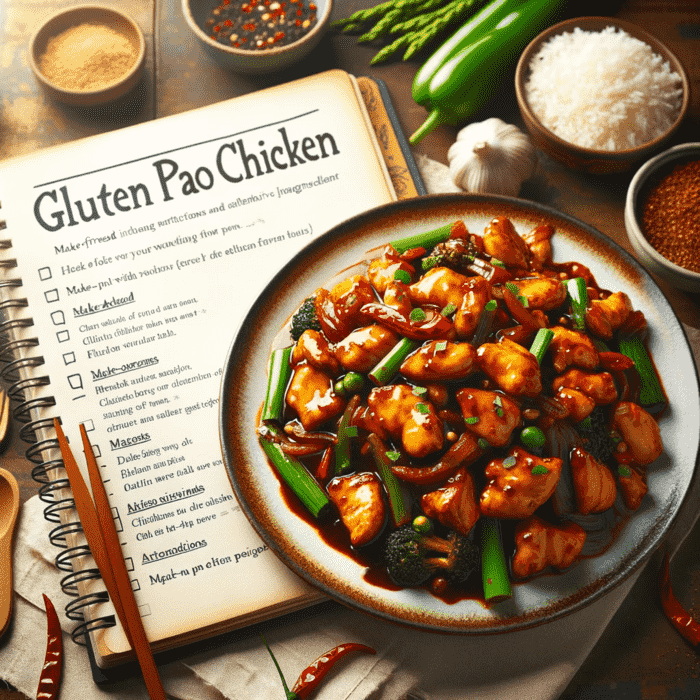
To whip up a delicious plate of Kung Pao Chicken, you’ll need a few essential tools to ensure everything comes together just right. Let’s take a look at what you’ll need:
A Wok or Skillet
A wok or large skillet is an absolute must-have. The high sides and wide surface area allow for even heat distribution, ensuring that your chicken and vegetables cook quickly and evenly.
A Sharp Knife
When preparing your Kung Pao Chicken, having a sharp knife on hand is crucial. You’ll need to cut the chicken and vegetables into bite-sized pieces, and a sharp knife will make this task much easier. Plus, it helps ensure that your ingredients are uniform in size for consistent cooking.
A Wooden Spatula or Tongs
To toss and stir the ingredients in the wok effectively, you’ll want to have either a wooden spatula or tongs at your disposal. These tools allow you to move the chicken and vegetables around without damaging them or scratching the surface of your wok.
Measuring Cups and Spoons
To achieve the perfect balance of flavors in your Kung Pao Chicken, accurate measurements of sauces and seasonings are essential. Using measuring cups and spoons ensures that you add just the right amount of each ingredient, resulting in a well-balanced dish bursting with flavor.
By having these essential tools ready in your kitchen, you’ll be well-equipped to create an authentic and delicious plate of Kung Pao Chicken. So gather up your wok or skillet, sharpen your knife, grab those measuring cups and spoons, and get ready to whip up a mouthwatering meal!
Gluten-Free Adaptability and Make-Ahead Instructions
To cater to those with gluten sensitivities or dietary restrictions, Kung Pao Chicken can easily be made gluten-free. Instead of using regular soy sauce, you can opt for tamari or gluten-free soy sauce as a substitute. This simple swap allows everyone to enjoy the bold flavors of this dish without compromising their health or preferences.
The key is to have all your ingredients ready to go. Take some time before cooking to chop the chicken, vegetables, and gather all the necessary spices and sauces. Store each ingredient separately in airtight containers until you’re ready to start cooking.
Leftover Kung Pao Chicken is a delightful treat that you can savor later on. If stored properly, it can last up to 3 days in the refrigerator or even longer if frozen. To reheat your leftovers, gently warm them either on the stovetop or in a microwave. This will help retain the flavors and textures of the dish, ensuring that every bite is just as delicious as when it was first cooked.
Serving, Leftovers, and Nutrition Information for Kung Pao Chicken
To enjoy a satisfying meal with kung pao chicken, serve it over steamed rice or noodles. The combination of tender chicken pieces, crunchy peanuts, and flavorful sauce will create a delicious blend of textures and tastes. Don’t forget to garnish it with some fresh green onions for an extra kick!
But what if you have leftovers? No worries! Leftover kung pao chicken can be repurposed in various ways. It makes a fantastic filling for wraps, sandwiches, or even salads. You can add some crisp lettuce, sliced cucumbers, and wrap it all up in a tortilla or stuff it between two slices of bread for a tasty lunch option.
While kung pao chicken is undeniably delicious, it’s important to note that it can be high in sodium due to the use of soy sauce. So if you’re watching your sodium intake or have any dietary restrictions, you may want to consume it in moderation or explore low-sodium alternatives.
When considering the nutritional content of kung pao chicken, keep in mind that it may vary based on the specific ingredients used and portion sizes. However, generally speaking, this dish is a good source of protein from the chicken and peanuts. It also contains essential vitamins and minerals from ingredients like bell peppers and garlic.
Remember to make adjustments according to your preferences and dietary needs when preparing this dish. Whether you’re serving it fresh or enjoying the leftovers creatively, kung pao chicken is sure to satisfy your taste buds with its bold flavors.
Appreciating the Delightful Kung Pao Chicken
Kung Pao Chicken is a dish that truly tantalizes the taste buds. With its combination of spicy, savory, and slightly sweet flavors, it’s no wonder why this dish is loved by so many. The contrasting textures of tender chicken, crunchy peanuts, and crisp vegetables add depth to each bite, making it a satisfying culinary experience.
The bold flavors of Kung Pao Chicken make it a favorite among spice lovers around the world. The dish typically features marinated and stir-fried chicken pieces coated in a rich Kung Pao sauce. This sauce is made from a blend of ingredients such as soy sauce, vinegar, sugar, and chili peppers. It’s this flavorful sauce that gives the dish its signature taste.
One of the great things about Kung Pao Chicken is its versatility. You can customize the dish according to your preferences by adjusting the level of spiciness or choosing your favorite vegetables to include. Whether you prefer it mild or extra spicy, with broccoli or bell peppers, you have the freedom to create a version that suits your taste.
There are various ways to savor this delicious dish. It pairs perfectly with steamed rice or noodles for a complete meal. Whether you’re cooking it at home or ordering from a restaurant, Kung Pao Chicken never fails to satisfy cravings for something flavorful and comforting.
Conclusion
The wonderful world of Kung Pao Chicken, exploring its traditional ingredients, cooking techniques, and even making an authentic recipe yourself. By now, you must have realized that Kung Pao Chicken is more than just a dish; it’s a delightful explosion of flavors and textures that will leave your taste buds dancing with joy.
FAQs
What makes Kung Pao Chicken spicy?
The spiciness in Kung Pao Chicken comes from two key elements: dried peppers and Sichuan peppercorns. These ingredients add a fiery kick to the dish, but don’t worry, you can adjust the spice level according to your preference.
Can I make Kung Pao Chicken gluten-free?
Absolutely! Many variations of Kung Pao Chicken can be made gluten-free by using tamari or gluten-free soy sauce instead of regular soy sauce. Just ensure that all other ingredients are also gluten-free.
Can I prepare Kung Pao Chicken in advance?
Yes, you can definitely prepare some aspects of Kung Pao Chicken in advance to save time when cooking. You can marinate the chicken beforehand or chop the vegetables ahead of time. However, it’s best to cook and assemble the dish just before serving for optimal freshness.
How should I serve leftovers of Kung Pao Chicken?
Leftover Kung Pao Chicken is still delicious! You can enjoy it cold as a salad topping or reheat it gently in a pan to maintain its flavors. Pair it with steamed rice or noodles for a quick and satisfying meal.
Is Kung Pao Chicken a healthy dish?
Kung Pao Chicken can be a healthy option if prepared with lean chicken, plenty of vegetables, and minimal oil. It’s packed with protein, vitamins, and minerals. Just be mindful of the sodium content in the sauce and adjust it according to your dietary needs.
Frequently Linked Pages
1. Dumplings Near Me – Dumplings Near Me: Best Deals & Delivery Options
2. Chop Suey – Chop Suey: A Delicious Culinary Adventure In Every Bite
3. Mapo Tofu – Mapo Tofu Recipe: The Authentic and Delicious Way!
4. Wonton – Wonton Making: The Ultimate Guide
5. Peking Duck – Peking Duck Recipe: Easy Home Version
6. Chinese Food – Chinese Food: A Gastronomic Adventure into Authentic Oriental Flavors
7. Chow Mein – Chow Mein: A Flavorful Exploration of the Classic Chinese Stir-Fried Noodles
8. Sashimi – Sashimi: A Guide To The Delicate Art Of Raw Seafood




